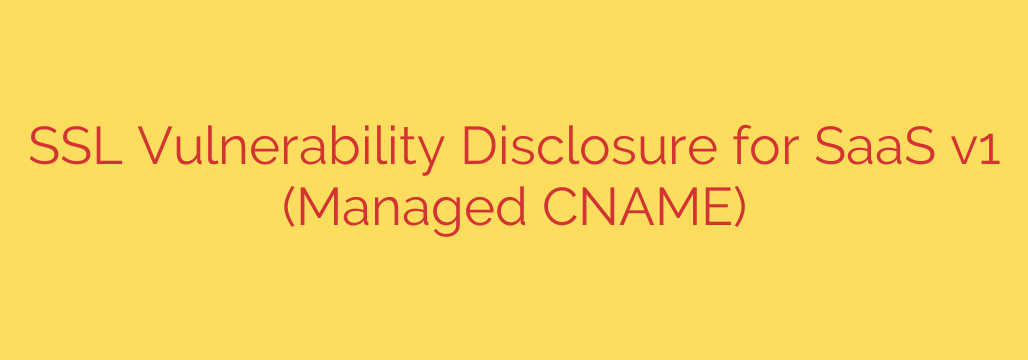
The Hidden SaaS Vulnerability: How CNAME Setups Can Expose Your SSL Keys
Using a custom domain for your favorite SaaS tool is more than a vanity feature; it’s a critical part of maintaining brand consistency. When your knowledge base, status page, or application lives at help.yourcompany.com instead of yourcompany.saasprovider.com, it builds trust and creates a seamless user experience. This is typically achieved with a simple DNS change—a CNAME record pointing your subdomain to the SaaS provider’s service.
While this setup is incredibly convenient, a significant security vulnerability has been identified in how some SaaS platforms manage the SSL certificates for these custom domains. This oversight could allow malicious actors to impersonate your brand and intercept sensitive user data. Understanding this risk is the first step toward securing your digital assets.
The Problem: Automatic Trust Based on a CNAME Record
The core of the issue lies in how SSL certificates are issued. To secure your custom domain with HTTPS, the SaaS provider needs to generate an SSL certificate for it. In a vulnerable setup, the provider’s system automatically assumes that if a CNAME record points to their infrastructure, the domain owner has granted them permission to manage its security.
This assumption is dangerous. The system proceeds to issue a certificate without any further validation. This means anyone who can point a domain they control to the same SaaS infrastructure could potentially exploit the system.
How the CNAME Vulnerability Works, Step-by-Step
A sophisticated attacker can leverage this flaw to gain unprecedented access. The attack unfolds in a few logical steps:
- Reconnaissance: An attacker identifies a SaaS provider that uses this vulnerable method for issuing SSL certificates.
- Pointing the Domain: The attacker takes a domain they own (
attacker-domain.com) and creates a CNAME record pointing it to the same SaaS provider’s infrastructure that you and other customers use. - Automatic Certificate Issuance: The SaaS provider’s automated system detects the new CNAME record and, without further checks, issues a valid SSL certificate for
attacker-domain.com. - The Critical Flaw: The private key for this newly issued SSL certificate is now stored on the SaaS provider’s shared server—the same server infrastructure that holds the private keys for you and all other customers.
- Exploiting a Second Vulnerability: The attacker then seeks another way to compromise that shared server. This could be through a separate, unrelated vulnerability like Log4j, a server-side request forgery (SSRF), or another remote code execution flaw.
- Private Key Theft: Once they gain access to the server, the attacker can potentially steal the private keys for every customer domain hosted on that infrastructure.
With your domain’s private SSL key in hand, an attacker can execute devastating attacks. They now hold the “master key” to your secure communications.
The Real-World Impact: What’s at Stake?
This isn’t just a theoretical problem. The consequences of a stolen SSL private key are severe and immediate.
- Website Impersonation: An attacker can perfectly clone your website or application on a server they control. Because they have the valid SSL certificate, browsers will show the trusted padlock icon, making the fake site indistinguishable from the real one.
- Man-in-the-Middle (MITM) Attacks: The attacker can position themselves between your users and your service, decrypting all traffic in real-time. This includes usernames, passwords, API keys, financial information, and other sensitive data.
- Complete Loss of Trust: Once a breach of this magnitude is discovered, the damage to your brand’s reputation can be irreparable. Customers will no longer trust that their data is safe with you.
Actionable Security: How to Protect Your Organization
Responsibility for fixing this vulnerability lies primarily with SaaS providers, but their customers also have a role to play in demanding better security.
For SaaS Providers:
- Implement Strong Domain Validation: The only reliable fix is to move beyond simple CNAME checks. Do not issue an SSL certificate until domain ownership is cryptographically verified.
- Use ACME-Based Challenges: Adopt standard validation methods like the HTTP-01 or DNS-01 challenges used by Certificate Authorities like Let’s Encrypt. These methods require the domain owner to either place a specific file on their server or create a specific DNS record, proving they control the domain.
- Audit Your Infrastructure: Conduct a thorough security audit of your certificate issuance and management process immediately. Assume your platform is a target and proactively identify and patch these kinds of architectural flaws.
For SaaS Customers:
- Question Your Providers: Reach out to your critical SaaS vendors and ask them directly about their SSL management process. Ask: “Do you perform domain ownership validation beyond a CNAME check before issuing an SSL certificate for my custom domain?”
- Demand Better Security: A provider’s inability to answer this question or confirm their validation methods should be a major red flag. Your security and your customers’ data depend on their diligence.
- Monitor Certificate Transparency (CT) Logs: For advanced security, you can monitor CT logs. These public logs record all certificates issued for your domains. While this won’t prevent the attack, it can alert you if a certificate is issued without your knowledge, allowing you to react faster.
Ultimately, convenience should never compromise core security principles. The way SaaS platforms handle custom domains and SSL certificates is a critical part of their security posture. Proper domain validation is not an optional feature; it is an absolute necessity for protecting businesses and their users in an interconnected world.
Source: https://blog.cloudflare.com/vulnerability-disclosure-on-ssl-for-saas-v1-managed-cname/








